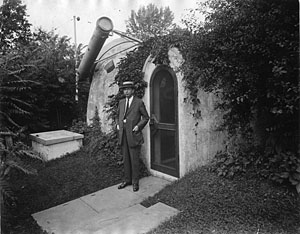

100th Anniversary of the Completion
of the Hartness Turret Telescope
By Bert Willard
Club Historian, The Springfield Telescope Makers
The year 2010 marks the 100th anniversary of the completion of the Hartness Turret Telescope. It is located on the grounds of the Hartness House Inn in Springfield. Vermont. The telescope is maintained in operational condition by the Springfield Telescope Makers, Inc. and is adjacent to the underground rooms that house the Hartness-Porter Museum of Amateur Telescope Making.

(date unknown)
In 1889 James Hartness, (1861-1934), was hired as plant superintendent at the Jones & Lamson machine shop, the first machine shop in Springfield. This was just the beginning of a string of advances that culminated in being promoted to president of the Jones & Lamson Machine Company. Along the way he was awarded over 100 patents on improved machine tools and measuring techniques, including the flat turret lathe that was the most financially rewarding. He was able to arrange for a $100 royalty for each machine manufactured and at one point was receiving $1000 per day in royalties.
After building his private home on Cherry Hill, his interest in astronomy inspired him to build a turret telescope of his own invention and later a tunnel from the home to the telescope and a series of underground rooms adjoining the telescope. The telescope was patented in 1912, and has a 10-inch Brashear objective. Other turret telescopes followed; a 10-inch Newtonian in Boston, Mass. in 1927, the 16-inch Porter Turret at Stellafane in 1930, a 5-inch refractor in Pennsylvania in 1932, and a 12-inch Newtonian in Penn. about 1942.
Hartness developed a passion for aviation during its infancy. He made his first flight in a zeppelin in Germany in 1913. Soon after, in 1914, he purchased his own Wright Flyer and learned to fly it at age 53. He became one of the first 100 certified pilots in the US. After his 1927 transatlantic solo flight, Charles Lindberg toured the US in the Spirit of St. Louis, stopping in every state to promote general aviation. The only airport in Vermont was Hartness’ in Springfield and Lindberg became Hartness’ guest. Today one of the guest rooms in the inn is named the Lindberg room to honor the event.
From his knowledge of optics gained from his interest in astronomy and telescope optics, Hartness invented an optical method of projecting a much magnified image of a screw thread onto a drawing thus showing if the thread was in tolerance. To develop his idea into a marketable machine he hired his close friend, Russell Porter, in 1919.
There is no known record of how much the telescope was used by Hartness. Was the telescope ever used for scientific research? From a story in the Springfield Reporter, October 31, 1951 we learn that Margaret Beardsley used the instrument for a number of years. She was the wife of Harty Beardsley, grandson of James Hartness. “Peg” Beardsley majored in astronomy at Mt. Holyoke College, class of 1934, and held a teaching fellowship in Astronomy at Smith in 1937. Her main interest was solar; doing sunspot counts and observing granulation and faculae, sending monthly reports to the US Naval Observatory, Washington, DC. Unusual or sudden changes were reported to the High Altitude Observatory in Climax, Colorado, or directly to Donald Menzel at Harvard Observatory.
From the AAVSO archives we learn that Peg joined the AAVSO in 1946 at the age of 33. She was chair of the AAVSO Occultation Committee during the 1950s. She submitted only two variable star observations using the Hartness Turret.
In a January 1956 correspondence she wrote that a new program would encourage Stellafane associate members who are interested in making useful and continuous observations (solar, variable star, or planets), and that she would act as a trainer for such interested observers.
Peg and Harty Beardsley moved to Montreal in 1960.
The story of how the Hartness Turret Telescope was restored in 1974 by the Springfield Telescope Makers can be found here on the Stellafane website, it’s a good read describing how unintended consequences can lead to the complete destruction of a telescope’s performance, only to be restored years later in the right hands.
Back to the Early History Page